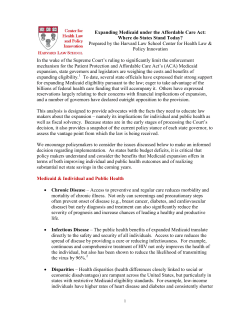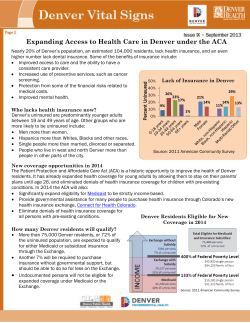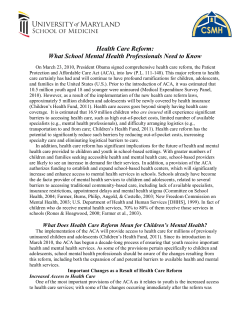
Report from the ACA Battlefront Medicaid, the ACA, and
Report from the ACA Battlefront Medicaid, the ACA, and the Supreme Court By Dennis J. Wall M Published in Experience, Volume 23, Number 1, 2013. © 2013 by the American Bar Association. Reproduced with permission. All rights reserved. This information or any portion thereof may not be copied or disseminated in any form or by any means or stored in an electronic database or retrieval system without the express written consent of the American Bar Association. 1 Image: iStockphoto ore than 58 million Americans rely on Medicaid for health care. Medicare, rather than Medicaid, is often thought to be the program that takes care of older people, but more than nine million Medicaid recipients are 65 years and older and enrolled in both Medicaid and Medicare—that is, more than nine million older Americans are “dual eligible,” relying on Medicaid, as well as Medicare, for their health care. In total, the Medicaid program is critical to the health and well-being of one-fifth of the U.S. population. The Affordable Care Act (ACA) would have extended Medicaid coverage to nearly 10 million more of the nearly 50 million uninsured people in our country. However, National Federation of Independent Business v. Sebelius has jeopardized that expansion and the health care that would have been provided as a result. Medicaid provides health insurance coverage to people with low incomes who fit within certain statutory categories. Medicaid is jointly funded by the federal and state governments. Participation in Medicaid is not mandatory, but all states currently do participate in Medicaid. The options available for state participation are many, but states must follow certain federal rules if they elect to participate in Medicaid. As of November 1, 2012, 14 states, including the District of Columbia, either expanded their Medicaid participation under the ACA or were leaning toward expansion, according to a report of the Center on Budget and Policy Priorities. Extrapolating from its conclusions, another 16 states expressed opposition to expansion, while the remaining 21 states were identified as “Unclear/Undecided.” As this article was readied for publication, additional states announced their decisions to join the Medicaid expansion under the ACA. These included Arizona, Florida, Michigan, Nevada, New Mexico, North Dakota, and Ohio. Reportedly, as of this writing, 22 states had elected to join the Medicaid expansion, 17 states opposed it, and 11 had not yet decided. This is not the end, however. Perhaps it is the beginning of the end, though. In Florida, as in many other states, expansion is subject to approval by the legislature. Florida’s Republican leaders have expressed misgivings. The legislative session began in March 2013, and, as reported in the New York Times, advocates said they planned to press ahead with a lobbying campaign. See Abby Goodnough & Robert Pear, G.O.P. Governors Providing a Lift For Health Law, N.Y. Times, Feb. 22, 2013, at A1. What Medicaid Was Back in the Day; What Medicaid Is Now Medicaid then and now can be contrasted best by comparing three variables: funding, financial eligibility, and categories of eligible participants. Dennis J. Wall (djw@ dennisjwall.com) is a sole practitioner specializing in insurance law. A frequent expert witness, consultant, and presenter on insurance questions, he is the author of Litigation and Prevention of Insurer Bad Faith, a co-author of CAT Claims: Insurance Coverage for Natural and Man-Made Disasters, and the author of two blogs available at www. abajournal.com/blawg/ insurance_claims_ and_issues and www. abajournal.com/blawg/ insurance_claims_bad_ faith_law_blog. Funding Funding Before the ACA: 1965–2010 Since its inception in 1965, Medicaid has featured shared funding participation by the states and federal governments, with each contributing a percentage of the shared cost. The higher share has always been contributed by the federal government, as it is now. The current average funding share of the federal government is 57 percent. eligibility for Medicaid is pegged to what is called the “federal poverty level” (FPL). The FPL is scaled on a gradient and sets different levels for people in different situations. So, for example, individuals qualify for one FPL setting, while a family of three qualifies for another, a family of four for yet another, and so on. The FPL is man-made, rather than a phenomenon of nature. The FPL did not exist before it was invented in Washington, D.C. When it was devised, perhaps the FPL provided a more or less reliable measure of what people could live on before they sank into “poverty.” If that was once true, however, it is certainly not true now. It is hard, if not impossible, to find any rational supporter of the idea that the FPL accurately measures the income that it takes for actual people to live on. The FPL long since stopped functioning, but it has remained a measure of Medicaid eligibility nonetheless. Funding After the ACA Under the ACA, the federal government will contribute a much greater share of the costs of an expanded Medicaid program. For the first three years of expansion—2014, 2015, and 2016— the share of the federal government in the costs of Medicaid expansion is 100 percent. The federal share is gradually reduced over the next four years until it reaches a plateau; it will be 95 percent in 2017, 94 percent in 2018, 93 percent in 2019, and 90 percent in 2020 and beyond. The federal officials in charge of Medicaid have given a friendly notice to state officials that the federal share is tied to these dates. Therefore, if a state elects not to expand its Medicaid rolls until, say, 2015, the federal government share will be at 100 percent levels for only two years, 2015 and 2016. If a state defers expanding Medicaid until 2017, the federal government will pay 95 percent of the expansion’s costs in 2017, rather than 100 percent. If a state waits until 2018, the federal share will be 94 percent of the Medicaid expansion in 2018, and so on. Eligibility Eligibility Before the ACA: 1965–2010 The financial eligibility requirements for Medicaid changed several times over the years between 1965 and 2010. Financial Eligibility After the ACA Under the ACA, Medicaid financial eligibility is expanded to people under the age of 65 with incomes equal to or less than 133 percent of the FPL. The scenario most often used to illustrate that figure is that of a family of three whose income rises to $25,390 in a single year. This measure takes effect in January 2014. Categories of Eligible Participants Previously established categories of Medicaid-eligible participants included pregnant women, children, parents, and adults with disabilities. The ACA, however, expands the Medicaid-eligible population to nearly all nondisabled adults under the age of 65. Medicaid Expansion after the Supreme Court Decision Chief Justice John Roberts wrote in the opinion for the Court that the Medicaid expansion issue is governed by the Spending Clause. That Clause, he said, is in the nature of a “contract” between the state and federal governments. On this point, four of the justices agreed in separate opinions. The ACA’s Medicaid expansion provisions included a requirement that states expand Medicaid or suffer the loss of all Medicaid funds, including the funding Published in Experience, Volume 23, Number 1, 2013. © 2013 by the American Bar Association. Reproduced with permission. All rights reserved. This information or any portion thereof may not be copied or disseminated in any form or by any means or stored in an electronic database or retrieval system without the express written consent of the American Bar Association. 2 that predated the ACA. Five justices, some expressing reluctance, combined for a majority holding that the “penalty” provision of the ACA Medicaid expansion was severable from the rest of the Medicaid expansion provided in the ACA, and seven justices severed it as violative of the Spending Clause. In general terms, the biggest effect on Medicaid of the June 2012 Supreme Court decision was to restrict the federal government’s ability to withhold all federal Medicaid sharing funds from states that elect not to join the federal government’s Medicaid expansion. The announced purpose of the ruling was to give states an unfettered choice as to whether to expand Medicaid coverage. As a result of the Supreme Court’s decision regarding Medicaid opt-out options, $53.3 billion more in medical bills will be incurred by hospital emergency rooms and many others, the National Association of Public Hospitals and Health Systems estimates. Further, the Congressional Budget Office currently estimates that six to 10 million fewer Americans will receive Medicaid as a result of the Supreme Court’s decision. Judges make decisions. And whether those decisions are correct on the legal and factual merits or not, it is indisputable that they have consequences. Among the consequences of the Supreme Court’s decision on the ACA’s Medicaid expansion are the responses of the federal government and of some state officials. The federal response to this decision has been to bend over backwards to accommodate it. Cindy Mann, director of the Center for Medicaid and Children’s Health Insurance Program Services (CMCS), the federal government official in charge of Medicaid, says states can choose to expand their participation in Medicaid. A state, she also says, at its own election can later decide to drop its expanded participation. The quoted responses of some state officials are variations on the theme of, it would be a mistake for us to rush into things. Their responses are reminiscent of “watchful waiting” in response to a diagnosis of cancer. Whether watchful waiting is a defensible response depends greatly on the status of the cancer and on which type of cancer has been diagnosed, as anyone who has had cancer knows very well. A diagnosis of prostate cancer is very different with respect to a watchful waiting option than, say, an aggressive lymphoma. Watchful waiting while millions of people continue to be barred from adequate access to health care will continue to prove as disastrous as it always has been. With respect to the ACA’s Medicaid expansion as it stands now, some state officials have expressed a desire to negotiate their state’s participation. They are quoted as having inquired whether they will be able to get 100 percent of the federal share of Medicaid costs in exchange for less than 100 percent compliance with the federal law. They have sometimes expressed their fear that, although the federal share is in place until 2020, there is a possibility that the states will be left paying all the costs of Medicaid someday—even though this has never been the case since the Medicaid law was first enacted nearly 50 years ago. Even if the federal government should eventually default on paying its share of Medicaid costs on some future day, it perhaps bears repeating that, on that day, every state and the District of Columbia will have the option of leaving the Medicaid expansion without any further payment. To quote Cindy Mann, the chief Medicaid official: “A state may choose whether and when to expand, and if a state covers the expansion group, it may decide later to drop the coverage.” Conclusion The ACA afforded an opportunity for a major expansion of Medicaid. That meant that many millions of people would have had more adequate access to health care. The federal share of the cost of Medicaid was greatly expanded, and the state share of the expense was monumentally reduced. Now the ACA’s Medicaid expansion provisions afford states the opportunity to opt out at any time after opting in. There is no deadline to join and no statutory penalty to withdraw. We are now entering the period of implementation of this historic statute. As the ACA wars play out, the battles on this front promise to be long and difficult. n Published in Experience, Volume 23, Number 1, 2013. © 2013 by the American Bar Association. Reproduced with permission. All rights reserved. This information or any portion thereof may not be copied or disseminated in any form or by any means or stored in an electronic database or retrieval system without the express written consent of the American Bar Association. 3 Postscript As this article was submitted for publication, it was widely reported that the Obama Administration was telling state officials that the Administration would encourage, rather than object to, the use of Medicaid subsidies to pay private insurance companies for insurance providing less coverage than Medicaid. This represents a policy shift reminiscent of the one reflected in the direct payment of federal funds to investment banks once the Troubled Assets Relief Program (TARP) passed Congress on the representation that TARP funds would be used to help troubled homeowners. Federal Medicaid money, therefore, will reportedly be used to pay, not for Medicaid, but for commercial health insurance available through ACA health insurance exchanges. See Robert Pear, Expanding Medicaid With Private Insurance, N.Y. Times, Mar. 22, 2013, at A14. Published in Experience, Volume 23, Number 1, 2013. © 2013 by the American Bar Association. Reproduced with permission. All rights reserved. This information or any portion thereof may not be copied or disseminated in any form or by any means or stored in an electronic database or retrieval system without the express written consent of the American Bar Association. 4
© Copyright 2025





















